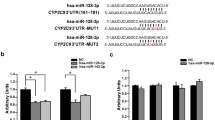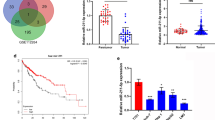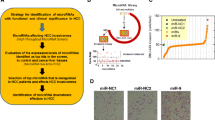Abstract
Background
Hepatocellular carcinoma (HCC) is a major contributor to the worldwide cancer burden. Recent studies on HCC have demonstrated dramatic alterations in expression of several cytochrome P450 (CYP) family members that play a crucial role in biotransformation of many drugs and other xenobiotics; however, the mechanisms responsible for their deregulation remain unclear.
Methods
We investigated a potential involvement of miRNAs in downregulation of expression of CYPs observed in HCC tumors. We compared miRNA expression profiles (TaqMan Array Human MicroRNA v3.0 TLDA qPCR) between HCC human patient tumors with strong (CYP-) and weak/no (CYP+) downregulation of drug-metabolizing CYPs. The role of significantly deregulated miRNAs in modulation of expression of the CYPs and associated xenobiotic receptors was then investigated in human liver HepaRG cells transfected with relevant miRNA mimics or inhibitors.
Results
We identified five differentially expressed miRNAs in CYP− versus CYP+ tumors, namely miR-29c, miR-125b1, miR-505, miR-653 and miR-675. The two most-upregulated miRNAs found in CYP− tumor samples, miR-29c and miR-653, were found to act as efficient suppressors of CYP1A2 or AHR expression.
Conclusions
Our results revealed a novel role of miR-653 and miR-29c in regulation of expresion of CYPs involved in crucial biotransformation processes in liver, which are often deregulated during liver cancer progression.
Graphical abstract






Similar content being viewed by others
Abbreviations
- AHR:
-
Aryl hydrocarbon receptor
- CYP:
-
Cytochrome P450
- HCC:
-
Hepatocellular carcinoma
- miRNA:
-
MicroRNA
- mRNA:
-
Messenger RNA
- NR1I2 (PXR):
-
Nuclear receptor 1I2, pregnane X receptor
- qPCR:
-
Quantitative polymerase chain reaction
- TCDD:
-
2,3,7,8-Tetrachlorodibenzo-p-dioxin
References
Bray F, Ferlay J, Soerjomataram I, Siegel RL, Torre LA, Jemal A. Global cancer statistics 2018: Globocan estimates of incidence and mortality worldwide for 36 cancers in 185 countries. CA Cancer J Clin. 2018;68:394–424.
Guengerich FP, Waterman MR, Egli M. Recent structural insights into cytochrome P450 function. Trends Pharmacol Sci. 2016;37:625–40.
Mittal B, Tulsyan S, Kumar S, Mittal RD, Agarwal G. Cytochrome P450 in cancer susceptibility and treatment. Adv Clin Chem. 2015;71:77–139.
Yan T, Lu L, Xie C, Chen J, Peng X, Zhu L, et al. Severely impaired and dysregulated cytochrome P450 expression and activities in hepatocellular carcinoma: Implications for personalized treatment in patients. Mol Cancer Ther. 2015;14:2874–86.
Chen H, Shen ZY, Xu W, Fan TY, Li J, Lu YF, et al. Expression of P450 and nuclear receptors in normal and end-stage Chinese livers. World J Gastroenterol. 2014;20:8681–90.
Brodeur CM, Thibault P, Durand M, Perreault JP, Bisaillon M. Dissecting the expression landscape of cytochromes P450 in hepatocellular carcinoma: towards novel molecular biomarkers. Genes Cancer. 2019;10:97–108.
Nekvindova J, Mrkvicova A, Zubanova V, Hyrslova Vaculova A, Anzenbacher P, Soucek P, et al. Hepatocellular carcinoma: gene expression profiling and regulation of xenobiotic-metabolizing cytochromes P450. Biochem Pharmacol. 2020;177:113912.
Kurzawski M, Dziedziejko V, Post M, Wojcicki M, Urasinska E, Mietkiewski J, et al. Expression of genes involved in xenobiotic metabolism and transport in end-stage liver disease: up-regulation of ABCC4 and CYP1B1. Pharmacol Rep. 2012;64:927–39.
Li D, Tolleson WH, Yu D, Chen S, Guo L, Xiao W, et al. Regulation of cytochrome P450 expression by microRNAs and long noncoding RNAs: epigenetic mechanisms in environmental toxicology and carcinogenesis. J Environ Sci Health C Environ Carcinog Ecotoxicol Rev. 2019;37:180–214.
Yu AM, Tian Y, Tu MJ, Ho PY, Jilek JL. MicroRNA pharmacoepigenetics: posttranscriptional regulation mechanisms behind variable drug disposition and strategy to develop more effective therapy. Drug Metab Dispos. 2016;44:308–19.
Gebert LFR, MacRae IJ. Regulation of microRNA function in animals. Nat Rev Mol Cell Biol. 2019;20:21–37.
Oura K, Morishita A, Masaki T. Molecular and functional roles of microRNAs in the progression of hepatocellular carcinoma—a review. Int J Mol Sci. 2020;21:8362.
Yang N, Ekanem NR, Sakyi CA, Ray SD. Hepatocellular carcinoma and microRNA: new perspectives on therapeutics and diagnostics. Adv Drug Deliv Rev. 2015;81:62–74.
Gholizadeh M, Szelag-Pieniek S, Post M, Kurzawski M, Prieto J, Argemi J, et al. Identifying differentially expressed microRNAs, target genes, and key pathways deregulated in patients with liver diseases. Int J Mol Sci. 2020;21:7368.
R Core Team. R: a language and environment for statistical computing. R foundation for statistical computing. 2018. https://www.R-project.org.
Carvalho BS, Irizarry RA. A framework for oligonucleotide microarray preprocessing. Bioinformatics. 2010;26:2363–7.
Ritchie ME, Phipson B, Wu D, Hu Y, Law CW, Shi W, et al. Limma powers differential expression analyses for RNA-sequencing and microarray studies. Nucleic Acids Res. 2015;43:e47.
Gripon P, Rumin S, Urban S, Le Seyec J, Glaise D, Cannie I, et al. Infection of a human hepatoma cell line by hepatitis B virus. Proc Natl Acad Sci USA. 2002;99:15655–60.
Andersson TB, Kanebratt KP, Kenna JG. The HepaRG cell line: a unique in vitro tool for understanding drug metabolism and toxicology in human. Expert Opin Drug Metab Toxicol. 2012;8:909–20.
Livak KJ, Schmittgen TD. Analysis of relative gene expression data using real-time quantitative PCR and the 2(-delta delta C(t)) method. Methods. 2001;25:402–8.
Laukova J, Kozubik A, Hofmanova J, Nekvindova J, Sova P, Moyer MP, et al. Loss of PTEN facilitates rosiglitazone-mediated enhancement of platinum(IV) complex LA-12-induced apoptosis in colon cancer cells. PLoS ONE. 2015;10:e0141020.
Zapletal O, Tylichova Z, Neca J, Kohoutek J, Machala M, Milcova A, et al. Butyrate alters expression of cytochrome P450 1A1 and metabolism of benzo[a]pyrene via its histone deacetylase activity in colon epithelial cell models. Arch Toxicol. 2017;91:2135–50.
Li Q, Song XW, Zou J, Wang GK, Kremneva E, Li XQ, et al. Attenuation of microRNA-1 derepresses the cytoskeleton regulatory protein twinfilin-1 to provoke cardiac hypertrophy. J Cell Sci. 2010;123:2444–52.
Rieger JK, Reutter S, Hofmann U, Schwab M, Zanger UM. Inflammation-associated microRNA-130b downregulates cytochrome P450 activities and directly targets CYP2C9. Drug Metab Dispos. 2015;43:884–8.
Kurtz CL, Fannin EE, Toth CL, Pearson DS, Vickers KC, Sethupathy P. Inhibition of miR-29 has a significant lipid-lowering benefit through suppression of lipogenic programs in liver. Sci Rep. 2015;5:12911.
Zhou F, Wang W, Xing Y, Wang T, Xu X, Wang J. NF-kappaB target microRNAs and their target genes in TNFalpha-stimulated Hela cells. Biochim Biophys Acta. 2014;1839:344–54.
Cen B, Lang JD, Du Y, Wei J, Xiong Y, Bradley N, et al. Prostaglandin E2 induces miR-675–5p to promote colorectal tumor metastasis via modulation of p53 expression. Gastroenterology. 2020;158:971–84.
Lee YS, Dutta A. The tumor suppressor microRNA let-7 represses the HMGA2 oncogene. Genes Dev. 2007;21:1025–30.
Ramadoss P, Marcus C, Perdew GH. Role of the aryl hydrocarbon receptor in drug metabolism. Expert Opin Drug Metab Toxicol. 2005;1:9–21.
Pastrakuljic A, Tang BK, Roberts EA, Kalow W. Distinction of CYP1A1 and CYP1A2 activity by selective inhibition using fluvoxamine and isosafrole. Biochem Pharmacol. 1997;21:531–8.
Borel F, Konstantinova P, Jansen PL. Diagnostic and therapeutic potential of miRNA signatures in patients with hepatocellular carcinoma. J Hepatol. 2012;56:1371–83.
Bronte F, Bronte G, Fanale D, Caruso S, Bronte E, Bavetta MG, et al. Hepatomirnoma: The proposal of a new network of targets for diagnosis, prognosis and therapy in hepatocellular carcinoma. Crit Rev Oncol Hematol. 2016;97:312–21.
Nasr MA, Salah RA, Abd Elkodous M, Elshenawy SE, El-Badri N. Dysregulated microRNA fingerprints and methylation patterns in hepatocellular carcinoma, cancer stem cells, and mesenchymal stem cells. Front Cell Dev Biol. 2019;7:229.
Vasuri F, Visani M, Acquaviva G, Brand T, Fiorentino M, Pession A, et al. Role of microRNAs in the main molecular pathways of hepatocellular carcinoma. World J Gastroenterol. 2018;24:2647–60.
Zhang Z, Li J, He T, Ouyang Y, Huang Y, Liu Q, et al. The competitive endogenous RNA regulatory network reveals potential prognostic biomarkers for overall survival in hepatocellular carcinoma. Cancer Sci. 2019;110:2905–23.
Bae HJ, Noh JH, Kim JK, Eun JW, Jung KH, Kim MG, et al. MicroRNA-29c functions as a tumor suppressor by direct targeting oncogenic SIRT1 in hepatocellular carcinoma. Oncogene. 2014;33:2557–67.
Wu H, Zhang W, Wu Z, Liu Y, Shi Y, Gong J, et al. MiR-29c-3p regulates DNMT3b and LATS1 methylation to inhibit tumor progression in hepatocellular carcinoma. Cell Death Dis. 2019;10:48.
Zhao L, Wang W. MiR-125b suppresses the proliferation of hepatocellular carcinoma cells by targeting Sirtuin7. Int J Clin Exp Med. 2015;8:18469–75.
Lu L, Qiu C, Li D, Bai G, Liang J, Yang Q. MicroRNA-505 suppresses proliferation and invasion in hepatoma cells by directly targeting high-mobility group box 1. Life Sci. 2016;157:12–8.
Ren L, Yao Y, Wang Y, Wang S. MiR-505 suppressed the growth of hepatocellular carcinoma cells via targeting IGF-1R. Biosci Rep. 2019;39:BSR20182442.
Hernandez JM, Elahi A, Clark CW, Wang J, Humphries LA, Centeno B, et al. MiR-675 mediates downregulation of Twist1 and Rb in AFP-secreting hepatocellular carcinoma. Ann Surg Oncol. 2013;20(Suppl 3):S625–35.
Jia HY, Wang YX, Yan WT, Li HY, Tian YZ, Wang SM, et al. MicroRNA-125b functions as a tumor suppressor in hepatocellular carcinoma cells. Int J Mol Sci. 2012;13:8762–74.
Zanger UM, Schwab M. Cytochrome P450 enzymes in drug metabolism: Regulation of gene expression, enzyme activities, and impact of genetic variation. Pharmacol Ther. 2013;138:103–41.
Shuaichen L, Guangyi W. Bioinformatic analysis reveals CYP2C9 as a potential prognostic marker for HCC and liver cancer cell lines suitable for its mechanism study. Cell Mol Biol (Noisy-le-grand). 2018;64:70–4.
Al-Dosari MS, Knapp JE, Liu D. Activation of human CYP2C9 promoter and regulation by CAR and PXR in mouse liver. Mol Pharm. 2006;3:322–8.
Gill P, Bhattacharyya S, McCullough S, Letzig L, Mishra PJ, Luo C, et al. MicroRNA regulation of CYP1A2, CYP3A4 and CYP2E1 expression in acetaminophen toxicity. Sci Rep. 2017;7:12331.
Takagi S, Nakajima M, Mohri T, Yokoi T. Post-transcriptional regulation of human pregnane X receptor by microRNA affects the expression of cytochrome P450 3A4. J Biol Chem. 2008;283:9674–80.
Nakano M, Nakajima M. Current knowledge of microRNA-mediated regulation of drug metabolism in humans. Expert Opin Drug Metab Toxicol. 2018;14:493–504.
Oda Y, Nakajima M, Mohri T, Takamiya M, Aoki Y, Fukami T, et al. Aryl hydrocarbon receptor nuclear translocator in human liver is regulated by miR-24. Toxicol Appl Pharmacol. 2012;260:222–31.
Ramamoorthy A, Li L, Gaedigk A, Bradford LD, Benson EA, Flockhart DA, et al. In silico and in vitro identification of microRNAs that regulate hepatic nuclear factor 4α expression. Drug Metab Dispos. 2012;40:726–33.
Takenaka MC, Gabriely G, Rothhammer V, Mascanfroni ID, Wheeler MA, Chao CC, et al. Control of tumor-associated macrophages and T cells in glioblastoma via AHR and CD39. Nat Neurosci. 2019;22:729–40.
Kwon JJ, Factora TD, Dey S, Kota J. A systematic review of miR-29 in cancer. Mol Ther Oncolytics. 2019;12:173–94.
Han N, Song YK, Burckart GJ, Ji E, Kim IW, Oh JM. Regulation of pharmacogene expression by microRNA in the cancer genome atlas (TCGA) research network. Biomol Ther (Seoul). 2017;25:482–9.
Joo MS, Lee CG, Koo JH, Kim SG. MiR-125b transcriptionally increased by NRF2 inhibits AHR repressor, which protects kidney from cisplatin-induced injury. Cell Death Dis. 2013;4:e899.
Drahushuk AT, McGarrigle BP, Larsen KE, Stegeman JJ, Olson JR. Detection of CYP1A1 protein in human liver and induction by TCDD in precision-cut liver slices incubated in dynamic organ culture. Carcinogenesis. 1998;19:1361–8.
Shimada T, Yamazaki H, Mimura M, Inui Y, Guengerich FP. Interindividual variations in human liver cytochrome P-450 enzymes involved in the oxidation of drugs, carcinogens and toxic chemicals: studies with liver microsomes of 30 Japanese and 30 Caucasians. J Pharmacol Exp Ther. 1994;270:414–23.
Faber MS, Jetter A, Fuhr U. Assessment of CYP1A2 activity in clinical practice: why, how, and when? Basic Clin Pharmacol Toxicol. 2005;97:125–34.
Yu J, Xia X, Dong Y, Gong Z, Li G, Chen GG, et al. CYP1A2 suppresses hepatocellular carcinoma through antagonizing HGF/MET signaling. Theranostics. 2021;11:2123–36.
Puga A, Xia Y, Elferink C. Role of the aryl hydrocarbon receptor in cell cycle regulation. Chem Biol Interact. 2002;141:117–30.
Marlowe JL, Puga A. Aryl hydrocarbon receptor, cell cycle regulation, toxicity, and tumorigenesis. J Cell Biochem. 2005;96:1174–84.
Koch DC, Jang HS, O’Donnell EF, Punj S, Kopparapu PR, Bisson WH, et al. Anti-androgen flutamide suppresses hepatocellular carcinoma cell proliferation via the aryl hydrocarbon receptor mediated induction of transforming growth factor-beta1. Oncogene. 2015;34:6092–104.
Faust D, Kletting S, Ueberham E, Dietrich C. Aryl hydrocarbon receptor-dependent cell cycle arrest in isolated mouse oval cells. Toxicol Lett. 2013;223:73–80.
Fan Y, Boivin GP, Knudsen ES, Nebert DW, Xia Y, Puga A. The aryl hydrocarbon receptor functions as a tumor suppressor of liver carcinogenesis. Cancer Res. 2010;70:212–20.
Yu D, Green B, Marrone A, Guo Y, Kadlubar S, Lin D, et al. Suppression of CYP2C9 by microRNA hsa-miR-128-3p in human liver cells and association with hepatocellular carcinoma. Sci Rep. 2015;5:8534.
Jiang CH, Yuan X, Li JF, Xie YF, Zhang AZ, Wang XL, et al. Bioinformatics-based screening of key genes for transformation of liver cirrhosis to hepatocellular carcinoma. J Transl Med. 2020;18:40.
Acknowledgements
The authors thank Karel Souček for instrument and core facility support, Petra Ovesná for statistical analysis and useful discussions, Zuzana Tylichová for help with EROD method, Jana Svobodová for technical assistance, Iva Lišková, Kateřina Svobodová, Martina Urbánková for technical support, Pavel Souček for help with antibody selection, and Jan Remšík for discussions.
Funding
Supported by Ministry of Health of the Czech Republic, grant No. 17-28231A. All rights reserved. The institutional support was provided by the long-term institutional funding of the Institute of Biophysics of the Czech Academy of Sciences (RVO: 68081707) and by Ministry of Health of the Czech Republic, DRO (UHHK, 00179906).
Author information
Authors and Affiliations
Contributions
Conceptualization, AHV, JN, JV; methodology, JN, MK, KN, JH, ZT; software, LR; formal analysis, MK, KN, LR, JN, AHV; investigation, MK, JN, KN, VZ, JH, LB, PF, PK; resources, JV, OS, IK, VP, ZK, LO; data curation, MK, JN, LR, KN, JH, AHV; writing—original draft preparation, AHV, MK, JN; writing—review & editing, AHV, JV, MK, JN, KN; visualization, MK, LR, JN, AHV; supervision, AHV, JN, JV; project administration, AHV, JN, JV; funding acquisition, JN, AHV.
Corresponding author
Ethics declarations
Conflicts of interest
The authors declare no conflict of interest.
Additional information
Publisher's Note
Springer Nature remains neutral with regard to jurisdictional claims in published maps and institutional affiliations.
Supplementary Information
Below is the link to the electronic supplementary material.
Rights and permissions
About this article
Cite this article
Krkoška, M., Nekvindová, J., Nevědělová, K. et al. Role of miR-653 and miR-29c in downregulation of CYP1A2 expression in hepatocellular carcinoma. Pharmacol. Rep 74, 148–158 (2022). https://doi.org/10.1007/s43440-021-00338-9
Received:
Revised:
Accepted:
Published:
Issue Date:
DOI: https://doi.org/10.1007/s43440-021-00338-9




